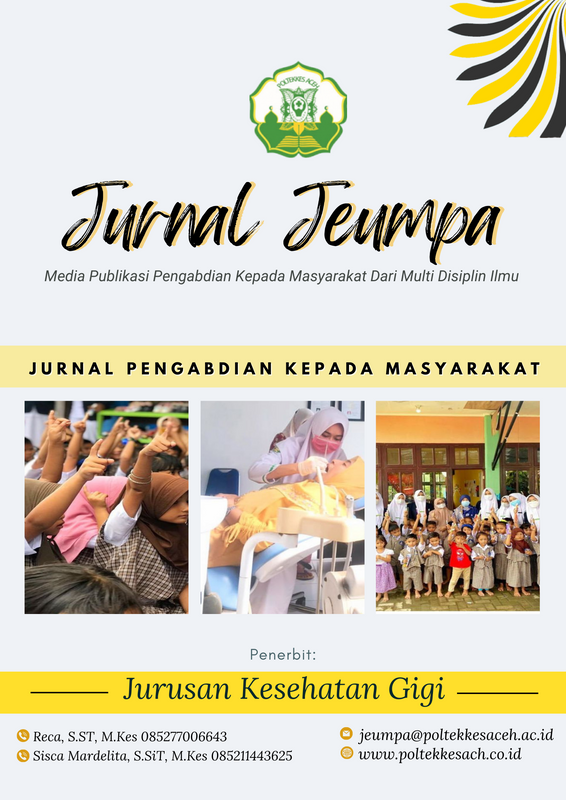Penyuluhan Kesehatan Tentang Pentingnya Pemahaman Keluarga Tentang Kondisi Fisik Rumah Sehat Sebagai Upaya Pencegahan Infeksi Saluran Pernafasan Akut (Ispa) Pada Balita
DOI:
https://doi.org/10.30867/jeumpa.v2i2.323Abstrak
The causing ARI; host (smoking, ability of host to transmit infection, immunity, nutritional status, previous infection/concurrent infection with other pathogens, general health condition). Characteristics of the pathogen (mode of transmission, infectivity, virulence, number, dose, inoculum size). Environmental conditions (air pollutants, density of family members, temperature, humidity, cleanliness, ventilation, season). Availability of health services (vaccines, access to health services, capacity of isolation rooms). Humans are exposed to air pollution through eye contact and respiratory tract, particulates enter the body through breathing and settle in the lungs to the alveoli. Particulate impacts can occur directly or indirectly. Directly causes: eye, nose, throat irritation, headache, nausea, muscle aches, asthma and flu. After several years of exposure: decreased lung function, heart, lung cancer can be fatal. The importance of raising awareness and understanding of the community, especially those who have toddlers through health counseling efforts for the physical environment of the house.
Referensi
Prevalensi ISPA pada Balita di Provinsi NTT. (Penelitian). Retrievedfrom.https://id.search=Pengaruh+Faktor+Individu%2C+Ibu+dan+Linkungan+Terhadap+Prevalensi+ISPA+pada+Balita+di+Provinsi+NTT&fr2=sb-top&hspart=trp&hsimp=yhs-001&type=Y61_F11_165725_122318. Diakses tgl 11 November 2019.
Pramayu, A.P. (2012). Hubungan konsentrasi PM10 ruang kelas terhadap ISPA pada siswa SD di Kecamatan cipayung Depok. (Tesis): Fakultas Kesehatan Masyarakat, Universitas Indonesia.
Syahidi, M.H., Gayatri, D., dan Bantas, K. (2013). Faktor-faktor yang Mempengaruhi Kejadian Infeksi Saluran Pernapasan Akut (ISPA) pada Anak Berumur 12-59 Bulan di Puskesmas Kelurahan Tebet Barat, Kecamatan Tebet, Jakarta Selatan. (Penelitian). Departemen Epidemiologi Fakultas Kesehatan Masyarakat, Univesitas Indonesia. Retrieved from http://journal.fkm.ui.ac.id/epid/article/view/1313. Diakses tgl 10 November 2019.
Krieger, J., & Higgins, D. (2002). Housing and Health: Time Again for Public Health. Am J Public Health. Vol. 92 (5).
Notoatmodjo, S. (2012). Promosi Kesehatan dan Perilaku Kesehatan. Edisi Revisi. Jarakta: PT Rineka Cipta.
Webster, M., dan Fransisca, H. (2010). Aksi Global Melawan Pneumonia pada Anak. Buletin Jendela Epidemiologi, Vol. 3, 2010.
Situs Internet:
IHME. (2014). Angka Kematian Anak Tertinggi. Retrieved from https://health.detik.com/anak-dan-remaja/d-2572886/angka-kematian-anak-paling-tinggi-di-dunia-ada-di-negara-ini. Diakses tgl 16 November 2019.
Kementerian Kesehatan RI. (2009), Profil Kesehatan Indonesia 2009. Jakarta. Retrievedfromhttp://www.depkes.go.id/.../Profil%20Kesehatan%20Indonesia%202008.pdf. Diakses tgl 22 November 2019.
Kementerian Kesehatan RI. (2011). Permenkes Nomor: 1077 Tahun 2011 Mengenai Pedoman Penyehatan Udara dalam Ruang Rumah. Retrieved from http://www.hukor.depkes.go.id/up_prod_permenkes/PMK%20No.%201077%20ttg%20Pedoman%20Penyehatan%20Udara%20Dalam%20Ruang%20Rumah.pdf. Diakses tgl 22 November 2019.
Riskesdas. (2018). Hasil Utama Riset Kesehatan Dasar Kementerian Kesehatan. Retrieved from http://www.depkes.go.id/resources/download/info-terkini/materi_rakorpop. Diakses tgl 23 November 2019.
Salfiyadi, T. (2019). Manajemen Pendidikan Kesehatan.
Salfiyadi, T., Mardiah, A., Faisal, T. I., Kesehatan, J., Poltekkes, G., & Aceh, K. (2023). Peran Perawat Gigi di Puskesmas Dalam Mendukung Transformasi Kesehatan The Role of Dental Nurses in Community Health Centers in Supporting Health. JEUMPA: Jurnal Pengabdian Kepada Masyarakat, 2(1), 64–70. https://doi.org/https://doi.org/10.30867/jeumpa.v2i1.199
Salfiyadi, T., & Nuraskin, C. A. (2022). Development Of Health Education Management Models In Elementary Schools. 12(02), 221–226.
Unicef. (2017). Level and Trend in Child Mortality. Retrieved from http://data.unicef.org/resources/levels-trends-child-mortality-2017. Diakses tgl 18 November 2019.
WHO. (2002). Health Aspects of Air Pollution with Particulate Matter, Ozone and Nitrogen Dioxide.Report on a WHO Working Group. Retrieved from http://www.euro.who.int/_data/assets/pdf_file/0005/112199/E79097.pdf. Diakses tgl 22 November 2019.
WHO. (2017). Jutaan Anak Meninggal Tiap Tahun Akibat Pencemaran Lingkungan. Retrieved from http://gakken-idn.id/articles/jutaan-anak-meninggal-tiap-tahun. Diakses tgl 12 November 2019.
File Tambahan
Diterbitkan
Cara Mengutip
Terbitan
Bagian
Lisensi
Hak Cipta (c) 2023 Fathimi Fathimi (Penulis); Hilma Yasni, Asmanidar, Orisinal, Asri Jumadewi (Penerjeman)

Artikel ini berlisensi Creative Commons Attribution-NonCommercial-NoDerivatives 4.0 International License.














